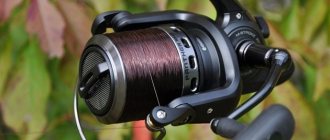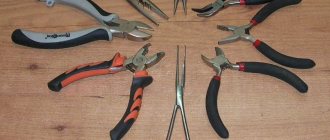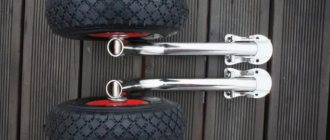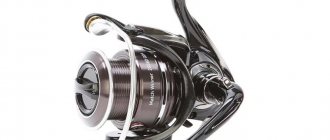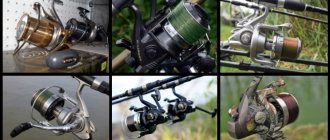Types of coils
All coils are divided into three types: inertial
,
inertia-free
and
multiplier
. One or another type of reel is selected depending on the fishing method.
Inertia coils
Inertial coil The simplest and most inexpensive coils are inertial; they are easy to operate and do not require special care. Most of these reels are not equipped with a braking mechanism, so during casting, to prevent unnecessary line slipping, the angler has to brake the reel drum with his finger. Only a small part of the inertial reels on the market have automatic braking systems, which are based on the fact that during casting, the line puts pressure on a special lever, which in turn is connected to the braking mechanism. A simpler braking option is a constant braking mechanism, when the angler independently sets the braking force of the drum based on the weight of the bait or load being thrown. When choosing an inertial reel, you should pay attention to the quality of the material from which the reel is made, the precise balanced rotation of the drum and the ease of its movement. On high-quality inertial reels, there must be a mechanism for regulating the rotation of the drum and reducing backlash, made in the form of a screw and a lock nut.
Spinning reels
Inertia-free reels are a universal and therefore the most common type of reel, so they should be given more attention.
Inertia-free reels are designed in such a way that when casting, the line is cast without any resistance, resulting in the longest cast possible. Such reels are quite complex and need to be constantly monitored and periodically lubricated (1-2 times a season) so that no unpleasant misunderstandings occur during fishing.
The main part that makes such casts possible is the spool. This is a cylindrical part on the axis of which a fishing line is wound.
When casting, the line flies off in rings without overcoming any resistance. Holds the line on the spool so that it does not fall off the line guide. It consists of a bow and a pass ring.
Spinning reel
The size of the spool and its capacity depend on the size of the reel itself. This should be taken into account when choosing a reel for a particular type of fishing. Of course, the diameter of the fishing line also plays a role (the larger it is, the less fishing line you can wind on the spool). For comfortable fishing, it is necessary that at least 100 m of fishing line be wound on the reel, preferably 150 m. First of all, this is necessary so that when a large fish bites, you have a reserve for catching it. It is also worth considering that some large loads (a large bait on a spinning rod or a heavy feeder on a bottom) can be thrown more than 70-100m. Do not forget that the length of the fishing line will constantly decrease due to tying and cutting knots (bottom equipment at the end of fishing or lures on a spinning rod when replacing them).
The amount of fishing line that fits on a given spool must be marked on it (with the exception of hand-assembled reels and some Chinese “creations”). The designations are as follows: 0.1-250; 0.15-200; 0.2-130, etc.
Everything here is intuitive - first the diameter of the fishing line is indicated, and then the length that will fit on this spool.
The second important part of the inertia-free reel is the clutch. This is an adjustable brake that determines the tension at which the spool will smoothly release the line when the line guide is closed. On different reels, it can be located on top of the spool (front), or behind the reel (rear). Today, most manufacturers put it in the front.
You can't do without a clutch when fishing for large fish. When configured correctly, it will dampen its jerks and prevent the line from breaking, even if the weight of the trophy significantly exceeds the test line. It is ideal to adjust the clutch so that the line unwinds from the spool with a tension of 2/3 of the strength of the line.
Multiplier reels
Multiplier reel The highest quality and most reliable are multiplier reels from well-known companies.
These are very complex mechanisms. Some of them have a huge "menu". It consists of numerous control systems with automatic braking, reverse braking, automatic line winding, and so on, right down to a computer built into the reel. Some models, the most modern and the most expensive, are even equipped with an angler location locator using space navigation systems. A modern multiplier reel is almost equal to a spinning reel in terms of ease and casting range, and has no equal in terms of power and reliability. The price of these reels remains quite high.
Structurally, a baitcasting reel is an inertial reel equipped with a gear system with a gear ratio that usually does not go beyond the limits of 3 to 7. The gear ratio is the numerical relationship between the number of handle revolutions and the number of spool revolutions. It is usually indicated on the reel body. Let’s say “Gear Ratio 4.4-1”, which means: with one revolution of the reel handle, the spool will make 4.4 revolutions. Thus, the gear ratio of this reel is 4.4.
An important element of a multiplier reel is a friction brake, which allows you to avoid tangling of the fishing line when casting. When purchasing a “cartoon”, learn how to use it correctly. In particular, carefully study the methods for adjusting the friction brake. It must be adjusted for each specific casting weight. Thus, the multiplier reel allows the line to flow straight out when casting, without twisting around its own axis. It is reliable and powerful, which allows you to remove even large and extra-large sea fish from the water. A multiplier reel can be used on almost all gear where reliability, power and quality are needed.
Inertial reel for spinning
The oldest type of spinning reel, the number one reel, is in the arsenal of the anglers of yesteryear. Nowadays, they have given way to other types of reels. However, even now, there are fans of spinning fishing with an inertial reel.
Description of the design of inertial coils
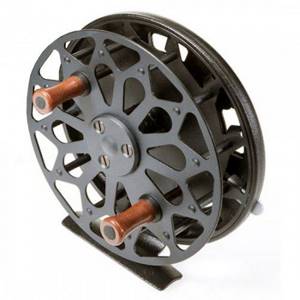
Inertial coils are quite simple in their design. A drum for winding line, a friction brake and a leg for attaching the reel to the fishing rod. Nowadays, lighter inertial reels are mainly used by float fishing enthusiasts and fans of winter fishing. Models that are heavier and more serious are also suitable for spinning fishing, including jig fishing.
Advantages of inertial reels
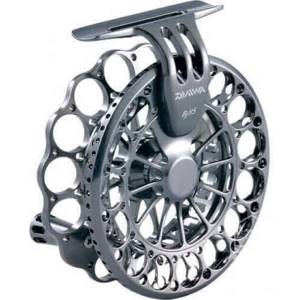
Inertial spinning reels have their advantages:
- An inertial reel is suitable in cases where heavy bait is used and casting over a long distance is not required
- Low cost compared to more complex and therefore more expensive spinning and multiplier reels
- Adaptability to almost any natural conditions
- Simplicity of design, reliability, “indestructible”, this is how experienced fishermen remember with bitterness about inertial reels
Disadvantages of inertial reels

Having listed the advantages of inertial coils, one cannot fail to mention their disadvantages:
- Winding the fishing line onto the inertial reel should be done with tension; experienced fishermen use a heavy book or other similar object for this.
- Casting bait is more complex, requiring some experience and skill. The inertia must be slowed down and stopped at the end of the cast, otherwise a “beard” of fishing line will form, which will then take a long time to untangle. Experienced spinning players advise first mastering the pendulum cast, and only then practicing swing casts.
It is precisely because of their shortcomings that inertial coils have lost popularity to inertialess ones.
Coil types
Fishing reels are:
- spinning;
- match;
- wiring;
- fly fishing;
- winter.
Choosing a reel takes professional fishermen a lot of time. Only at first glance this is a fairly ordinary object.
Reels come in different types and characteristics. The simplest is a hand reel
. It is made with a handle that must be turned manually to reel in the fishing line. There are no automatic devices provided here. However, this reel is inconvenient because when a bite occurs, you may not be able to react in time and miss the catch.
There are also semi-automatic reels
. The fishing line is wound onto them by hand, but a device is used that makes the work easier and stabilizes the speed, because this reel has a brake.
There are also automatic reels
.
They reel in the line automatically. The reel appeared as a device for storing a supply of fishing line on a fishing rod. Ice fishing reels
Ice fishing reel
During ice fishing, when we fish at great and not very deep depths, it is advisable to use a small reel with a brake and a ratchet. The fact is that when reeling out the fishing line, you have to lay it directly on sharp ice, and this causes the fishing line to deteriorate and may break, getting tangled in sharp pieces of ice.
Anglers who like to fish in the winter on ice are popular with ice fishing rods that also have small portable reels that fit right into the hollow handle of the winter fishing rod.
Winter tackle is considered more advanced and is called running tackle if a winter reel is attached to the rod instead of a reel. Along the entire length of the fishing rod, passage rings are strengthened at a certain distance from each other, through which the fishing line passes through. Running rigging is advantageous in that it allows you to cast bait and bait further than usual, quickly maneuver with the length of the fishing line, and fish for large fish on a thin leash.
Sea fishing reels
Reel for fishing at sea For sea fishing, much more practical are reels with a plastic, “graphite”, as they say, body, rotor and spool, which practically do not change their properties from the action of sea water.
It is also advisable to give preference to models that do not have too many “balls” - this has little effect on the ease of movement of the reel, but maintaining a reel with four ball bearings and one roller is much easier. By the way, the roller bearing itself, which works as an instant stopper for the rotor's reverse motion, can quickly become unusable in sea fishing conditions.
Therefore, a simple (and reliable) multi-point backstop will be more practical.
Of course, reels for sea fishing must be monitored and maintenance done after each sea fishing trip, that is, rinse under running fresh water (do not immerse in water!), remove sand and dust with a clean, dry cloth, lubricate with liquid lubricant (1-2 drops) line roller and handle cam axis.
Materials used in reels
There are two materials that are used in the manufacture of reels: plastic and metal. At the same time, there are hundreds of types of plastic, each of which differs in strength and wear resistance. Metal in coils is also a broad concept, because even in one model, several types of metals can be used simultaneously. For example, the body may be made of titanium alloy, the spool made of machined aluminum, the line guide made of stainless steel, gears made of bronze alloy, etc. In the vast majority of cases, the reel design consists of both plastic and metal parts, although there are both all-metal and all-plastic models. It is not recommended to purchase the latter, since these products, to put it mildly, do not differ in quality.
Multiplier reel for spinning rod
Multiplier reels are still not very common among our fishermen, although they are very popular abroad. The popularity of these reels is growing every year and more and more anglers are no longer avoiding them. Many spinning anglers, who pick them up for the first time and make a few casts, begin to understand that even a novice angler can handle such a reel.
Description of the design of multiplier reels

The multiplier reel is suitable for different types of fishing, with different bait weights, from the lightest to baits weighing more than 60 grams. The multiplier reel successfully combines all the advantages and disadvantages of inertial and inertia-free reels, although the design of such a reel is more complex.
The multiplier reel is a kind of modernized and improved version of the inertial reel, but in reality it is more like a compact winch. To make casting easier, there is a “trigger” located near the reel holder. Which in the lower position completely frees the spool. The reel is located close to the axis of the blank, so you can control the rotation of the spool with your finger, which allows you to make more accurate casts from different positions, avoiding tangling of the fishing line and the formation of a “beard”, plus it provides better tactile sensitivity through your fingers.
In the upper position of the “lever” the spool is clamped as much as possible, and in order for the clutch to work, effort must be made. In the middle position, the “lever” snaps into place. This zone is usually used at maximum loads on the tackle. Thus, by moving the lever, the angler will find his “golden mean” for himself.
It is better not to install a multiplier spinning reel on a regular spinning rod, it is not suitable for it, you need to purchase a casting spinning rod, it is better balanced, has the required handle length and a larger number of rings, and a reel seat that is convenient for the multiplier.
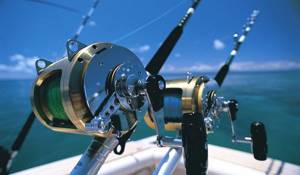
Before using the spinning reel, it is necessary to unscrew the spool and treat all elements with a napkin soaked in kerosene, thereby ridding it of excess lubricant. But in general, it is better to clean it after every fishing, this helps to increase its service life. The friction brake must be adjusted before use.
For beginning spinning anglers, in order to learn how to cast, it is still better to choose a more budget-friendly reel option. As a rule, these are low-profile reels; they are also called “soap boxes” in fishermen’s slang. But when choosing between a plastic and metal case, you should not save money and choose the second one, as it is more reliable. Low profile spinning reels have a long casting range for light lures, small diameter lines and thin braid.
You might be interested in: Trout tune. Killer melody
Professional fishermen who practice power fishing use spinning reels with a high profile or simply a “barrel” for medium and large-sized baits. The weight of such a spinning reel can reach 1500g. They can be used for sea and trophy fishing, for trolling.
Advantages of baitcasting reels
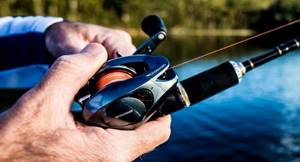
The advantages of a multiplier reel are obvious:
- Design reliability
- High power, which is especially appreciated by sea fishing enthusiasts
- Simplicity, compactness and absence of unnecessary parts
- High sensitivity and control over the line during fishing
- Ease of use
Disadvantages of baitcasting reels
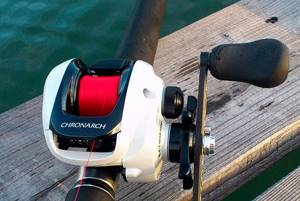
Baiting reels also have their disadvantages, which are mainly encountered by novice fishermen:
- A more complex casting technique that requires some experience and skill to do it right. Beginner fishermen especially often face this problem; they have to untangle more than one “beard” from the fishing line before mastering and practicing the correct casting technique.
- The braking system of the multiplier reel must be adjusted each time to the conditions, type of fishing, and bait used; this requires some experience.
- The price of a baitcasting reel is usually higher than that of a different type of reel.
- A baitcasting reel requires a special rod, which you will have to purchase.
- For different weights of baits, a reel of its own size is required, small reels are designed for a bait weight from 4 to 14 grams, medium-sized reels are designed for all baits up to 40 grams, heavy reels are designed for a bait weight of 60 grams or more. When buying a medium-sized universal baitcasting reel, you may have problems casting light-weight lures.
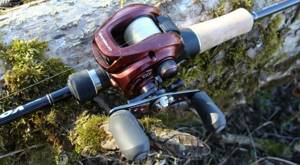
Basic parameters of coils
Nowadays there is a huge variety of reels on the market. Below are the parameters of the reels that you need to pay attention to when choosing: gear ratio, number of bearings, type and volume (capacity) of the spool, weight and size of the reel. You can learn about all of the listed parameters from the inscriptions on the reel itself, on its packaging, or ask the seller. Based on these parameters, you should make your choice.
There are also many additional auxiliary systems installed on modern reels, but they, as a rule, do not have a significant impact on fishing performance, although they can be very useful and convenient.
Main settings
the following:
- Number of bearings
. You can learn about the number of bearings (more precisely, ball bearings) from the inscription containing the words “ball bearing”. Can range from 0 to 12–15 pieces. Bearings are necessary for more stable and smooth operation of mechanisms. The greater the number of bearings, the longer the reel will last, but at the same time, it will cost more. But, as you know, it is best to choose the “golden mean”. - Gear ratio
. Simply put, it shows the ratio of a full revolution of the handle to the corresponding number of revolutions of the line guide. Indicated on the reel after the words “Gear racio”. Ranges from 1:3.2 to 1:7.2. Reels with the smaller of the specified gear ratios (1:3.2–1:4.6) are used for spin fishing. Faster reels in spinning conditions will not allow you to move the bait smoothly and evenly at a slow speed. In addition, the lower the gear ratio, the more “powerful” the reel is, the less effort you will have to cope with large fish. But you don't need this for a float rod. High-speed reels (1: 5.2–1: 6.2) are more effective when float fishing. Reels with a medium gear ratio (1:: 4.6–1: 5.2) are suitable for both spinning rods (if medium and fast retrieving is required) and float fishing rods. These can be said to be the most versatile reels. - Friction brake
. An absolutely necessary item. Designed to prevent the scaffold from breaking when a jerk exceeds its breaking load. In this case, the spool begins to rotate, releasing the line until the load decreases. - Assistive devices Long Cast, Hyper Cast, Match Spool
. You can find all these phrases on a long-casting reel. The system, externally characterized by a special, elongated spool shape, allows you to make ultra-long casts and use thin line without increasing the spool diameter. We must remember that in order to make a long cast of the bait, it is necessary to wind the line almost to the cheek (top edge) of the spool. And if you use thin line on a regular spool, you will have to wind thicker line under thin line or wind too much line. The Match Spool system allows you to avoid this. The longer the spool (the inscriptions “Long Cast” or “Gyper Cast”), the fewer turns of line there will be on it, therefore, the less its resistance to slipping. - Zero backlash system
. With the coming into fashion of “braids” and other heavy-duty fibers, many began to complain about the fragility of the reels. This is due to the fact that each reel is designed for a certain load, and if you get a hook on a “braided line”, which, with the same thickness as a monofilament line, has a breaking load several times greater, and you pull the boat to the hook using a spinning rod, then It’s not surprising to break the coil. The design load is indirectly indicated on the spool through the diameter of ordinary, non-braided fishing lines placed on the spool, because we know the average value of the maximum breaking load for a fishing line of a given thickness. Try to use a line whose diameter is the second to last one indicated on the spool. In this case, the reel will serve you as long as possible. If you still need to use “braid” (especially large fish, the possibility of frequent snags, fishing from the shore), then purchase more powerful or special reels. - Anti-vibration system for winding the line onto the spool.
“AVS”, “Dyna balance” - if you see these inscriptions on the reel, then your reel is equipped with this system. The mentioned system is often used in conjunction with the “Double Handle” system - double handle. Both systems are necessary to prevent spatial oscillatory movements of the spool (and therefore harmful vibration of the entire reel) as it rotates. It combines a double symmetrical handle or a handle with a compensator, as well as a balanced line guide. The compensator on the handle is a small free-form body made of heavy material. This system is very practical, provides a chance to enjoy fishing and is worth the money spent. The “Double Handle” system, in addition, serves to quickly grab the handle after casting - it becomes “handy” in any position. - "Anti-Twist", "Twist Free Roller", "Power Roller"
. These inscriptions indicate that the reel is equipped with an anti-twist system - a special shape of the line roller that reduces the twisting of the line. It is transferred to the end of the line, which has not yet been wound onto the reel, and the line is placed on the spool, twisted 20–40% less. The system is also worth the money spent, because with its line it becomes less twisted, which means it is less likely to get tangled when casting. - "Auto Cast", "Speedcast", "Quick Fire"
. The listed inscriptions indicate that the reel is equipped with a semi-automatic casting system, which consists of a lever for retracting the line guide bracket and a plate (or something else) for gripping the line. Casting with the help of such a system is carried out as follows: we pull the cocking lever towards ourselves, while the line guide bracket moves to the side, and the plate grabs the line; we cast while holding the lever; we release the lever at the moment when we usually release the line; the lever is set to the middle position, the plate releases the line and the nozzle flies to the desired point; close the line guide bracket, the lever is set to its original position. The system is not very effective, and sometimes even interferes with fishing. It does not affect the casting speed. Additional protruding parts appear that the scaffolding can cling to. The reel becomes heavier. The tension of the line is not felt at the moment of casting, because the line is held not by your finger, but by the plate.
Spinning reel
This is the most popular type of reel used by spinners these days.
Description of the design of spinning reels

The appearance of a spinning reel is known to every fisherman; because of their appearance, they are also called “meat grinders”.
An inertia-free reel consists of a spool with a line wound on it, a line handle with a roller, a rotating rotor, a body containing the reel mechanism, a handle and a foot of the reel, with which it is attached to the reel seat of the fishing rod.
All spinning reels are equipped with a friction brake, which can be front or rear.
Advantages of spinning reels
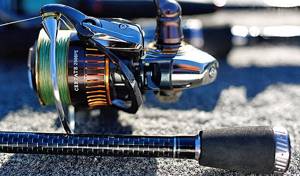
- The advantages of inertialess reels many times exceed their disadvantages:
- Versatile, spinning reel is suitable for different fishing methods: spinning, float fishing, trolling, feeder.
- Manufacturability, manufacturers constantly keep up with the times, reduce the weight of reels, constantly increase their strength and reliability, use modern, innovative materials and technologies.
- Large selection of sizes, gear ratios, materials, prices. Every fisherman can choose a reel that suits his fishing conditions and budget.
- Simplicity of design and ease of use, even for novice anglers.
You may be interested in: DaMiKi Pirami 55S. Scout hero.
Disadvantages of spinning reels
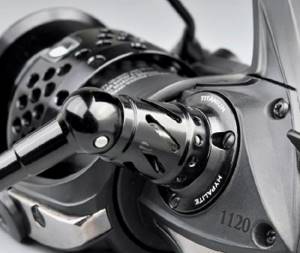
With all the advantages that spinning reels have, we can mention two of their significant disadvantages:
- Price, a good quality spinning reel costs a lot. It is better for a novice fisherman to first purchase a reel from a budget price range, and later, having figured it out and learned how to fish with it, move on to a more serious option.
- The need for careful treatment and care. A modern spinning reel is a technically complex product that requires careful attention and care. If used carelessly and incorrectly, even an expensive and high-quality reel will not last long.
Tips for caring for your reel
Do not forget that the reel requires constant care. Here are some rules:
- Avoid getting sand and moisture into the coil
- Protect the reel from shocks and falls
- The reel should be tightly attached to the rod. If it is weaker, it may fall off; if it is stronger, the coil may be damaged.
- Transport the reel in a durable case to avoid damage.
- Loosen the friction brake of the reel when storing it, this way all the gaskets will be in a relaxed state and will retain their structure for a longer time.
How to choose a coil based on the test?
Quite often the rod and reel are purchased separately. And although all recommendations were followed when choosing both the first and second, it turns out that they do not suit each other and do not work correctly. Therefore, it is important to understand whether a reel is suitable for spinning and how to choose the best option.
Don’t be upset in advance, since choosing a spinning rod and reel is easy if you know their parameters.
- I equip spinning rods with 10–12 g dough with reels no larger than 2000.
- When testing 10–30 g, you should set the coil from 2000 to 3500.
- For spinning rods with large dough, products with sizes from 4000 to 5000 are suitable.
Knowing the necessary parameters, choosing a spinning reel for a spinning rod will not be as difficult a task as it seemed at first. You should definitely familiarize yourself with them before choosing a reel for your spinning rod, so that you don’t regret your purchase in the future.

